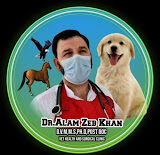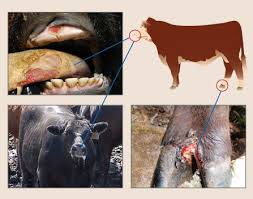Foot-and-Mouth Disease (FMD) is a highly contagious viral disease affecting cloven-hoofed animals, including cattle, buffalo, sheep, goats, and pigs. Known for its rapid spread and significant economic impact, FMD leads to severe production losses, trade restrictions, and animal suffering. The disease is characterized by fever and the formation of painful blisters (vesicles) in the mouth, on the feet, and teats. Understanding FMD is vital for cattle farmers to protect their herds and livelihoods.
Etiology of FMD in Cattle:
-
FMD is caused by the Foot-and-Mouth Disease Virus (FMDV), a member of the Aphthovirus genus in the Picornaviridae family.
-
There are seven serotypes (O, A, C, Asia 1, SAT 1, SAT 2, SAT 3) with no cross-immunity between them.
-
The virus is highly resilient and can survive in contaminated animal products, soil, and the environment for extended periods under favorable conditions.
Pathology:
-
FMDV enters the body via inhalation, ingestion, or skin abrasions.
-
The virus multiplies locally and spreads through the bloodstream (viremia) to target epithelial tissues.
-
Vesicles form in the mouth, tongue, dental pad, hooves (coronary band), and teats.
-
The rupture of these vesicles leads to ulcers, secondary bacterial infections, lameness, and difficulty in feeding.
Clinical Signs:
-
Fever (40°C–41°C) in the early stages
-
Vesicles/blisters in the mouth, on the tongue, dental pad, lips, gums, and nostrils
-
Salivation and drooling due to oral pain
-
Lameness and reluctance to move because of foot lesions
-
Loss of appetite and difficulty chewing
-
Drop in milk production in lactating cows
-
Abortion and myocarditis in young calves (“tiger heart disease”)
Diagnosis:
-
Clinical signs (vesicles in mouth and feet) are often diagnostic.
-
Laboratory tests confirm the diagnosis:
-
ELISA
-
RT-PCR
-
Virus isolation
-
Complement fixation test
-
Treatment:
-
No specific antiviral treatment exists for FMD.
-
Supportive care includes:
-
Soft, easily eaten foods and fresh water
-
Mouthwash with mild antiseptics or astringents
-
Foot baths (e.g., copper sulfate solution)
-
Antibiotics to prevent secondary bacterial infections
-
Pain management if necessary
-
Prevention:
-
Vaccination with local serotypes in endemic regions
-
Biosecurity:
-
Quarantine of new animals
-
Restrict movement between farms
-
Disinfection of equipment, vehicles, and footwear
-
-
Prompt reporting of suspected cases
-
Proper disposal of infected carcasses
- 👉 Watch our detailed video on FMD in cattle on YouTube:
Foot-and-Mouth Disease in Cattle – Full Guide
Conclusion:
Foot-and-Mouth Disease in cattle is a major animal health concern, leading to economic loss and animal distress. With vigilant vaccination programs, biosecurity, and early diagnosis, cattle farmers can effectively manage and prevent outbreaks. Watching educational materials, like our YouTube video on FMD, can help farmers stay informed and proactive.
FAQs
1. Can FMD infect humans?
Human infections are extremely rare and usually mild.
2. How is FMD spread?
Through direct contact with infected animals, contaminated materials, air (short distances), and animal products.
3. Can vaccinated cattle still get FMD?
Vaccination reduces risk significantly, but complete protection is not guaranteed, especially if vaccine strains don’t match circulating virus.
4. Can recovered cattle spread FMD?
Yes, some recovered cattle may become carriers and spread the virus without showing signs.
5. Where can I learn more about FMD?
Watch our FMD in Cattle Video on YouTube for a complete guide!


